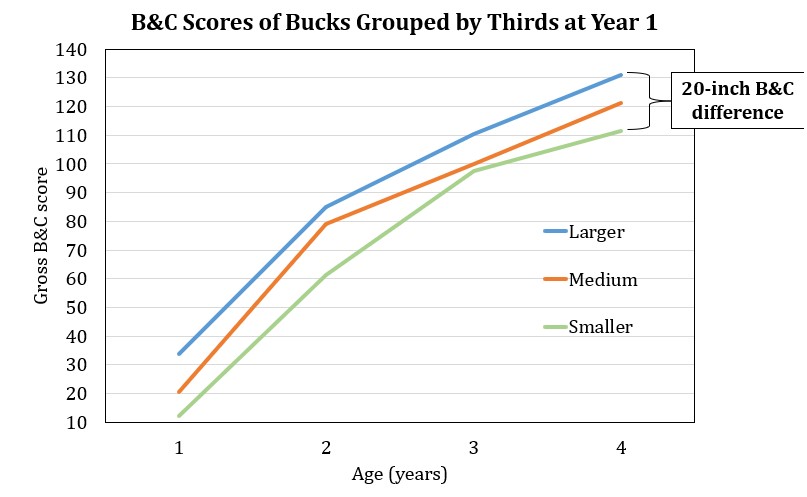
Written by: Kevin Owens and Pierce Young
White-tailed deer (Odocoileus virginianus) management involves regulating deer populations to maintain a healthy balance between deer, habitat, and hunting interests. Buck management refers to strategies used to influence the structure and quality of the male deer population, often with a focus on improving antler size and overall herd health. When it comes to harvesting “management” bucks or “cull” bucks, timing and purpose are everything. Before pulling the trigger it’s important to understand when (and why) these harvests actually may benefit your deer herd. These management decisions should be based on clear goals, herd condition, and solid data.
Considerations Before Harvesting Management Bucks:
Do you own or manage large acreage (or work with a cooperative)?
- Bucks can have home ranges of 1,000-3,000 acres on average
- Yearling (1.5-year-old) bucks disperse, typically during the rut, and can move miles away to establish their home range.
Are your management goals to ensure your largest antlered bucks reach their full potential?
Are you meeting your doe harvest quota?
- Influencing herd dynamics through doe management is much more important and harvesting management bucks.
Are bucks on your property reaching maturity (5.5+ years old)?
Can you consistently age bucks on-the-hoof?
If the answer is "No" to any of these questions, then harvesting "Management/Cull" bucks may not be right for you.
Why even consider it?
A 200 lb buck eats roughly 2 tons of forage per year. That’s a lot of groceries that could be available to better-quality antlered bucks and your does.
There is only so much space. If your "trophy" buck criteria is very high, you may likely still have too many deer on your property, even if you are reaching your doe harvest quota. You may still have overcrowding of bucks that don't meet your "trophy" criteria and many of your best younger bucks are likely moving out.
What does the research say?
Long-term research (Texas, MSU Deer Pens, and the MSU Lowndes County Study) showed that while you can’t perfectly predict an individual buck’s future at 1.5 years old, patterns emerge when bucks are grouped into thirds and tracked to older ages:
Upper third group: Most stayed top-end at older ages with the largest antlers, but some dropped.
Middle third group: Could swing either way up or down from 1.5-years-old to older ages.
Bottom third: Most stayed bottom-end to older ages with the smallest antlers.
In Lowndes County Mississippi (27,000 acres, 24 landowners, 182 bucks studied), the difference in antler size at maturity between the top and bottom thirds was huge — 18-20 inches B&C score.

How to use this information on your property?
If your property isn't big enough, join your neighbors together in a "deer management cooperative".
Focus first on your doe harvest quota.
If you can, use habitat management (e.g., timber stand improvements, prescribed burns, food plots, etc.) to support healthy deer
If you still have too many deer, have your best bucks reaching maturity, and you can decently age on-the-hoof: maybe shooting management bucks is right for your property.
Use camera surveys and age/antler averages to find the bottom 1/3rd of each age class.
1.5 year old bucks are the most naive and visible.
Target most 1.5 year old management bucks after dispersal (post-rut season). These are your next year's 2.5 year olds that have setup their home range on your property.
Avoid removing 2.5-year-olds (too much risk vs reward if a mistake happens - don't want to shoot your best 1.5 year olds).
Harvest any bucks that are 3.5-years-old, or older, that fall within the "bottom-third" category for their age class.
Bucks reach maturity at 5.5-years old. Any mature bucks should be harvested, not matter what size antlers are on his head.
Consult with a private lands biologist through a free site visit or sign up for DMAP (Deer management assistance program) to work with a biologist annually on how to manage the deer herd on your property. For more information about managing deer populations please visit our website at www.mdwfp/privatelands.com
Example Buck Harvest "Hit List":
• Yearling spikes less than 3”
• 3.5+ year-olds with less than 7 points
• All mature bucks (5.5+ year olds)
Remember: the old “once a spike, always a spike” myth isn’t true. But by removing the lowest-quality bucks before and after maturity, you can help shift your herd toward better overall condition, and have more space for better quality bucks—if your other management practices are in place first.
To hear a deeper discussion on this topic checkout the episode